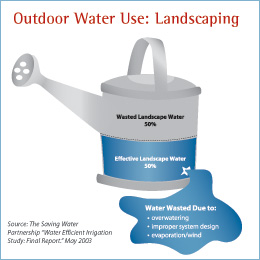- WaterSense
- Outdoor Water Use in the US
Outdoor Water Use in the United States
An American family of four can use 400 gallons of water per day, and about 30 percent of that is devoted to outdoor uses. More than half of that outdoor water is used for watering lawns and gardens. Nationwide, landscape irrigation is estimated to account for almost one-third of all residential water use, totaling more than 7 billion gallons per day. Other residential outdoor uses include washing automobiles, maintaining swimming pools, and cleaning sidewalks and driveways.
Water use varies greatly depending on geographic location and season, largely as a result of differences in climate. Water withdrawals for irrigation and landscaping are highest in the drier regions of the West and Southwest, where population growth is often greatest.

Some experts estimate that up to 50 percent of commercial and residential irrigation water use goes to waste due to evaporation, wind, improper system design, or overwatering. Following are some common outdoor water inefficiencies, but there are simple solutions to reduce water waste and produce great results:
- Many people water their lawns too often and for too long, oversaturating plants. It's usually not necessary to water grass every day. Instead, test your lawn by stepping on a patch of grass; if it springs back, it doesn't need water.
- Converting to a water-efficient landscape through proper choice of plants and careful design can reduce outdoor water use by 20 to 50 percent.
- If homeowners with irrigation systems hired WaterSense irrigation partners to perform regular maintenance, each household could reduce irrigation water by 15 percent or about 9,000 gallons annually—or the amount of water that would flow from a garden hose nonstop for nearly a whole day.
- Soil moisture sensors determine the amount of water in the ground available to plants. These sensors, when professionally installed and properly maintained, can potentially save a household more than 11,000 gallons of water used for irrigation annually.
WaterSense, a partnership program sponsored by the U.S. Environmental Protection Agency, seeks to help homeowners and businesses improve water efficiency and reduce their costs by promoting efficient irrigation technologies such as weather-based irrigation controllers and soil moisture sensors. For more information, visit www.epa.gov/watersense.
This document also available in PDF (2 pp, 158K, About PDF).










